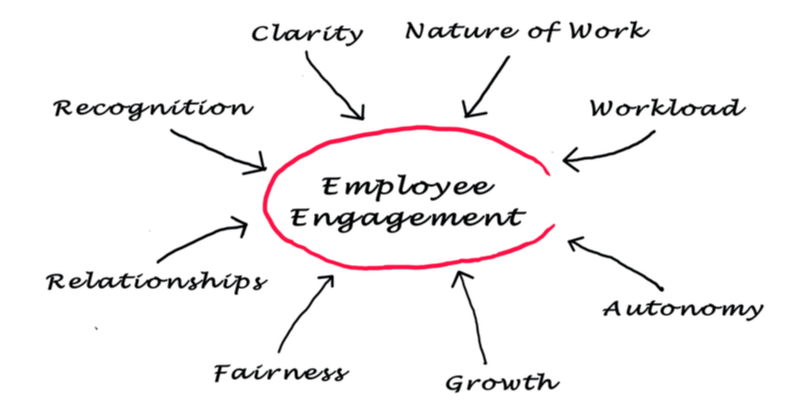
By
Leanna Seah
October 16, 2024
Updated
October 16, 2024
Why global employee engagement matters
Working across global teams has become part of the norm and its advantages are seemingly limitless.
Employers can build remote teams and hire the best talent without batting an eyelid over geographical boundaries. Companies can also unite individuals from various backgrounds to encourage inclusion and diversity within their organisational structures.
This meeting point of distinct experiences and perspectives is fuel for encouraging unique and progressive ways to take on strategic challenges.
Managing global teams involves more than just hosting regular virtual team building sessions. It involves recognising that your culturally diverse employees are made up of individuals. All of whom may have very different ways of solving problems, interacting, and collaborating.
To meet diverse expectations and ensure employees feel valued and engaged, managers need new strategies to improve employee engagement.
What is employee engagement?

Source:arka38/Shutterstock
A big question for businesses is ''How to Increase employee engagement levels?"
Employee engagement is fundamental in ensuring workplace conditions provide employees with the resources they need to feel committed and passionate about their role and the company.
An engaged employee is enthusiastic about contributing to the company and willing to act to further the company’s efforts and goals.
A 2020 employee satisfaction survey by Gallup revealed that “the behaviours of highly engaged business units results in 21% greater profitability” for the company.
The same study also theorised that highly engaged employees are less likely to leave a company. It recorded that highly engaged business units have 59% less turnover in high-turnover organisations and 29% less turnover in low-turnover organisations.
As companies invest in growth, business leaders increasingly recognise the importance of people-oriented factors. High levels of employee engagement can directly impact a business’s success.
Harvard Business Review supports this view. It notes that: “Having a highly engaged workforce not only maximises a company’s investment in human capital and improves productivity, but it can also significantly reduce costs, such as turnover, that directly impact the bottom line.”
Improving engagement revitalises your company’s growth strategy. In an increasingly competitive business ecosystem and with a more discerning workforce, it helps you rise above the noise and stand out from the crowd.
.png?width=800&name=factors%20most%20likely%20to%20bring%20success%20(1).png)
Information sourced from Harvard Business Review's report: The Impact of Employee Engagement on Success
The challenges of engaging global employees
Historically, employee engagement strategies focused on creating great environments for teams sharing the same office space and time zone. However, these tactics no longer suffice with the rise of remote work and global teams.
Remote working introduces unique challenges in maintaining engagement levels. Disengaged employees often struggle with communication barriers absent in a shared office. New hybrid employees, in particular, can struggle to assimilate and actively participate in company culture.
Disengaged workers are often linked to the rise of quiet quitting, a phenomenon in which employees reduce their effort and commitment to their roles, doing only the bare minimum required. This can severely impact productivity and employee morale across the organisation. It's also costly, with quiet quitting estimated to cost the global economy nearly $9 trillion annually.
Restructuring benefits also raises challenges, especially if perks are tailored to a specific location. Learning and development opportunities must also be accessible to remote workers, and fostering bonds between teams from different countries and cultures is crucial.
How to increase employee engagement
- Provide your employees with open communication channels
- Set your employees up for long-term success with effective onboarding strategies
- Maximise employee well-being with meaningful benefits
- Facilitate employee growth with learning and development programs
- Partner with mobility services to work with global employees

Provide your employees with open communication channels
An open and collaborative culture is the cornerstone of a connected workforce. This becomes far more complex when employees are scattered across territories and time zones.
Managers must create a strategic internal communications plan to ensure their teams are engaged and prevent remote employees from feeling siloed. Utilising employee engagement surveys can help identify the drivers of employee engagement and tailor strategies accordingly.
Regular team check-ins ensure continuous information flow across all levels. For teams working collaboratively, individual employees must be clear on their responsibilities and those of their colleagues.
Casual one-to-one check-ins are also valuable. Encouraging employee feedback and making employees feel comfortable sharing their thoughts and concerns without judgment shows that their well-being is prioritized.
Trust comes full circle when employees feel trusted with privileged information and can speak sincerely. This trust is a valuable asset for any company and department.
Sharing important information about company decisions and, as managers, sharing personal details helps create a more relaxed corporate culture built on honesty and openness.

Set your employees up for long-term success with effective onboarding strategies
A well-developed onboarding strategy improves new employee retention by 82%. It is essential to helping new hires quickly assimilate within the organisation. It sets the tone for a positive employee experience and helps new employees feel more connected to an organisation, its people and culture, and its goals.
The sooner a new employee feels part of the team, the better. This means finding the sweet spot between providing them with autonomy and tools to find their footing while supporting them along the way. A great onboarding strategy is essential for setting your employees up for success.
For many companies, partnering with a third-party company to manage their onboarding plan can be a lifesaver, especially for global businesses or those with plans to expand into new markets. Hybrid workers, who may be remote or spread across various locations, particularly benefit from a structured onboarding process.
International expansion often involves ongoing hiring and onboarding, with added responsibilities of adhering to international labour policies, updating compensation structures, personnel training, and filing accurate documents with government authorities. Working with a specialist can help streamline your onboarding process even when your new employees are remote and scattered across multiple territories.
Working with a specialist can help you streamline your onboarding process even when your new employees are remote and scattered across multiple territories.
Experienced onboarding specialists can help you create custom training components, oversee self-onboarding systems, and much more, ensuring the entire process is handled promptly and consistently. This approach enhances workplace satisfaction and encourages effective workplace communication.
It allows business leaders to focus on other aspects of the company's growth while reassuring new hires are equipped with the knowledge and guidance they need to perform their responsibilities effectively. Successful organisations understand the importance of robust onboarding to maintain high engagement and productivity levels.

Maximise employee well-being with meaningful benefits
A well-thought-out benefits plan can significantly influence your employees’ quality of life, directly impacting their productivity and engagement. It tells your employees that you are invested in their well-being and sets you apart from your competitors, serving as an additional avenue to attract and retain talent.
For example, Salesforce provides its staff with wellness, travel, and educational programs. Their employees receive commuter benefits, with reimbursements of up to $270 a month in pretax dollars on public transport and parking expenses.
Salesforce also offers 100% reimbursement on the costs of fees, tuition, and textbooks for employees who take a pre-approved, job-related course at an accredited academic institution.
Employee benefits packages can vary depending on the type of organisation, role, or location. Benefits for full-time employees can look very different from those offered to independent contractors. For international companies, the benefits provided to employees based in their Singapore office, for example, would not necessarily match those offered to staff in the United States.
Providing your employees with a package that aligns with their circumstances can ease their day-to-day challenges and improve their welfare, making a huge difference in their job satisfaction.
A comprehensive benefits plan can also positively impact mental health by reducing stress and providing support where it is needed most.

Facilitate employee growth with learning and development programs
Hiring from within presents a positive feedback loop for the whole staff to observe. Employees see that you reward loyalty and dedication, and the team feels more engaged and likely to put in extra effort to stand out and succeed. Your best assets are already present in your company. – William Craig. Forbes.com
Whether through professional development programs such as upskilling, education sponsorships, or leadership training, investing in your employees' personal development is essential to building a culture of innovation and progress within your company.
Finding great talent can be difficult, and retaining it is even harder. If you have high-quality employees, why not invest in them? Foster a talent pool of loyal, motivated leaders who already know your company's ins and outs and are poised for upward mobility and clear career paths.
These opportunities lead to an increase in employee engagement and encourage employees to look forward to their future within the company. They also help managers identify the strengths and weaknesses of their team members. All of this contributes to improved organisational performance.
Employee recognition is vital to this process. Recognising employees' achievements and progress reinforces their commitment and motivation, further enhancing engagement levels.
Nevertheless, certain employees, like individual contributors, may be content and satisfied with their current roles. Presenting them too many opportunities and responsibilities before they’re ready might seem overwhelming instead of encouraging. This is the time to communicate, pay attention to your employees' needs, and act accordingly.

Partner with mobility services to work with global employees
Versatility and attentiveness are two key components that managers must have when addressing the nuances of leading global employees.
Working with local partners and third-party services (also known as global mobility partners) can alleviate the stress of international expansion for companies that already have a presence in or are planning to expand into foreign markets.
An Employer of Record (EOR) for example, can help your company launch its business activities in a new country and start hiring talent almost immediately. Without having to set up a physical entity.
In addition to that, they are responsible for overseeing payroll, employee screening, managing benefits rollout, conducting new hire training and much more. All while ensuring your expansion plans are compliant with local regulations.
Furthermore, by leveraging their expertise in the local culture, companies can gain insight into managing the expectations of foreign employees while respecting their social norms and cultural practices.
Being mindful of these elements whilst finding ways to incorporate new ideas and concepts is integral to maintaining effective employee engagement for the long term.
Learn more about Airswift’s Employer of Record services
From global HR consulting to payroll outsourcing and visa sponsorships, Airswift’s Employer of Record (EOR) services are designed to help businesses of all sizes simplify their international expansion. We provide a full range of services that can be customised to a business’ needs and adapted along the way.
A global company with a local touch, we have successfully supported businesses around the world during various stages of growth. Contact us today to learn more about our services and how we can work together.
